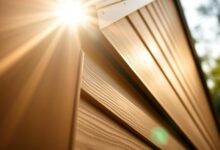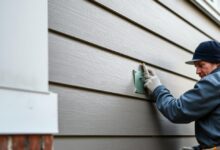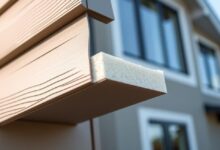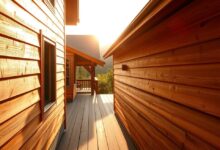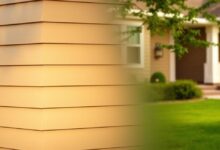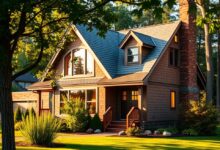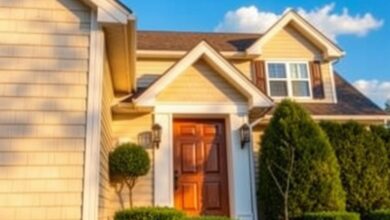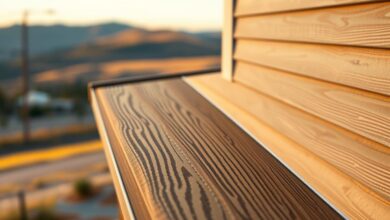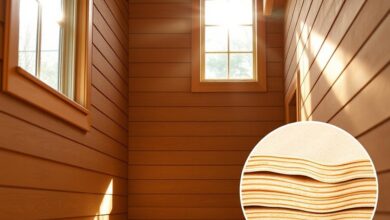Discover the Benefits of Insulated Siding
Homeowners in the United States are always looking to improve their homes. They want them to look better and work better. Insulated siding has become popular because it offers many benefits.
When thinking about home improvement, many wonder if insulated siding is worth it. It’s definitely worth considering. It can make your home more energy-efficient and last longer. Let’s dive into the benefits of insulated siding and see if it’s right for you.
Key Takeaways
- Energy efficiency improvements with insulated siding
- Enhanced durability and reduced maintenance
- Potential increase in property value
- Better resistance to environmental factors
- Improved overall comfort and home aesthetics
What Is Insulated Siding and How Does It Work?
Insulated siding combines the protection of traditional siding with new insulation tech. It makes a strong outer layer for homes. This product keeps your home safe from weather and helps keep it cozy inside.
It works by blocking outside temperatures. This means less heat loss in winter and less heat in summer. Its design has a foam layer in the middle, between the siding and the house wall.
The Structure and Components of Insulated Siding
Insulated siding has several parts that work together. The outside layer, made from vinyl or fiber cement, fights off weather and looks good. The foam insulation in the middle boosts energy saving.
| Component | Material | Function |
|---|---|---|
| Exterior Layer | Vinyl, Fiber Cement | Weather Resistance, Aesthetic Appeal |
| Insulation Layer | Foam | Energy Efficiency, Thermal Performance |
| Backing Layer | Various | Structural Integrity, Additional Insulation |
The Science Behind Insulation Technology
The tech in insulated siding stops heat from moving too much. This makes homes more energy-efficient. The foam layer is key, filling gaps and blocking temperature changes.
Knowing how insulated siding works shows its value. It uses new materials and methods to improve home comfort and energy use.
Top Benefits of Insulated Siding for Your Home
Insulated siding is changing the game in home improvement. It brings many benefits that make your home better to live in and look good. This new exterior solution does more than just look nice; it offers many practical advantages.
Energy Efficiency and Lower Utility Bills
Insulated siding makes your home more energy efficient. It adds an extra layer of insulation. This helps keep your home warm in winter and cool in summer.
Your heating and cooling systems work less hard. This leads to lower utility bills and big savings over time.
A well-insulated home can save up to 30% on energy bills. This makes it a smart choice for saving money on energy.
Enhanced Comfort and Sound Reduction
Insulated siding also makes your home more comfortable. It keeps the temperature inside more even. Plus, it reduces outside noise, making your home quieter and more peaceful.
Improved Durability and Impact Resistance
Insulated siding is built to last longer than regular siding. It can handle extreme weather and temperatures. This improved durability means it needs less maintenance and lasts longer.
Environmental Benefits and Reduced Carbon Footprint
Insulated siding is also good for the environment. It helps lower your carbon footprint by reducing heating and cooling needs. Plus, many insulated siding products are recyclable or made from sustainable materials.
In short, insulated siding offers many benefits. It can make your home more efficient, comfortable, and valuable. Whether you want to save on energy, improve durability, or reduce environmental impact, insulated siding is a great choice for your next home project.
Exploring Different Types of Insulated Siding
There are many types of insulated siding available. It’s important to know what each offers. This way, homeowners can choose the best option for their homes.
Vinyl Insulated Siding Options and Features
Vinyl insulated siding is loved for its durability and easy care. It comes in many styles and colors. This lets homeowners personalize their home’s look.
- Improved energy efficiency: Vinyl siding keeps homes warm in winter and cool in summer.
- Resistance to weathering: It stands up to rain and extreme temperatures.
- Low maintenance: Vinyl siding doesn’t rot, mold, or mildew easily.
Fiber Cement Insulated Products
Fiber cement siding is durable and eco-friendly. It’s made from cement, sand, and cellulose fibers. This siding offers:
- Enhanced durability: It resists pest and weather damage.
- Fire resistance: It’s non-combustible, adding safety to homes.
- Versatility: It can be painted or finished in many ways.
Comparing Foam Backed vs. Integrated Insulation Systems
Insulated siding comes in two main types: foam-backed and integrated. Foam-backed siding has foam insulation on the back. Integrated systems have insulation built into the siding.
The main differences are:
| Characteristics | Foam Backed | Integrated Insulation |
|---|---|---|
| Insulation Performance | Good | Excellent |
| Installation Complexity | Moderate | Simplified |
| Cost | Variable | Generally Higher |
Knowing about the different insulated siding types helps homeowners make a smart choice. They can pick what fits their needs and budget.
Is Insulated Siding Worth It? A Cost-Benefit Analysis
To figure out if insulated siding is a good buy, we need to look at a few things. We should check the upfront cost, long-term energy savings, how it affects home value, and regional factors.
Understanding the Initial Investment
Insulated siding costs more than regular siding at first. This price includes the materials and the work to put it up. On average, homeowners pay between $10 to $15 per square foot, depending on the siding type.
Several things can change the initial cost:
- The type of insulated siding (vinyl, fiber cement, etc.)
- The complexity of the installation
- Regional labor costs
Calculating Long-Term Energy Savings
Insulated siding helps save energy. It adds an extra layer of insulation. This means less heat loss in winter and less heat gain in summer. Homeowners can save 10% to 30% on energy bills, depending on their location and current insulation.
To figure out long-term savings, think about:
- Current energy use and costs
- Energy savings with insulated siding
- How long it takes to pay back the initial cost
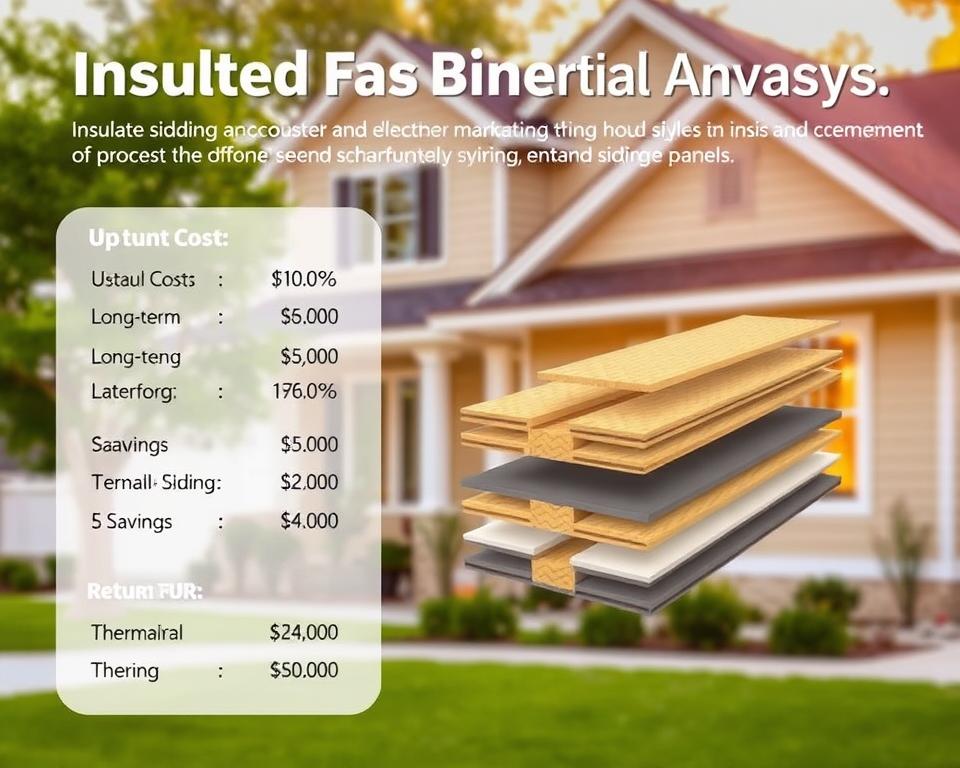
How Insulated Siding Affects Home Value
Insulated siding can also boost a home’s value. It looks good and works well. Potential buyers often see insulated siding as a plus, because it means lower energy bills and less upkeep.
Regional Considerations: Climate Impact on Value
The value of insulated siding changes by region, mainly because of climate. In colder areas, the energy-saving benefits are bigger. This can make the home more valuable than in warmer places.
Important regional factors include:
- Average temperature and heating/cooling needs
- Local building codes and energy standards
- What buyers in the area like
By looking at these points, homeowners can decide if insulated siding is right for them.
Installation and Maintenance: What Homeowners Should Know
Insulated siding needs the right installation and care to last long. Homeowners should think about several things to make sure their siding works well for years.
Finding the Right Contractor vs. DIY Approaches
Choosing between a professional contractor and DIY siding installation is a big decision. DIY might save money, but it often misses the precision and warranty of pros. A good contractor ensures the siding is put in right, avoiding problems like water damage or bad insulation.
“Getting a professional contractor is a smart choice,” says an experienced builder. “They guarantee a perfect job, give homeowners peace of mind, and offer a warranty.”
To pick the right contractor, homeowners should:
- Look for local contractors with experience in insulated siding
- Check their licenses, insurance, and customer feedback
- Get detailed quotes and compare what they offer
Long-Term Care and Expected Lifespan
Good long-term care is key for insulated siding to last. Homeowners should check the siding for damage, clean it yearly, and keep the landscaping away from it.
By doing these simple maintenance tasks, homeowners can make their insulated siding last longer. The expected lifespan depends on the material. Vinyl siding can last up to 30 years or more, and fiber cement can last decades with the right care.
In the end, the right installation and care are essential for enjoying insulated siding’s benefits. These include saving energy and lasting longer.
Conclusion: Making the Smart Choice for Your Home’s Exterior
Insulated siding brings many benefits to homeowners. It saves energy, makes homes more comfortable, and lasts longer. It’s also good for the environment. Knowing about insulated siding helps homeowners make smart choices for their homes.
Thinking about insulated siding? Consider the upfront cost and long-term savings. It can also raise your home’s value. With proper installation and care, it’s a wise choice for your home’s look and function.
Choosing insulated siding means a more comfortable, eco-friendly, and valuable home. It’s a smart move for anyone looking to improve their home’s exterior.
